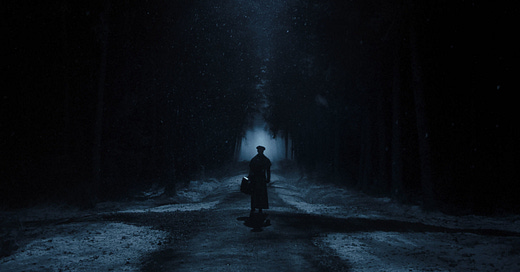[Spoiler Alert: This article contains spoilers for Nosferatu (2024)]
“Providence! Providence!”
An overly charismatic Herr Knock (Simon McBurney) repeats that to Thomas Hutter (Nicholas Hoult), a nervous newlywed considering embarking upon the journey to sell an outdated estate to a cryptic old Count. “Providence,” he says, before reassuring Thomas that if he sells this account, he’ll earn a long-term position with the firm. Not much later, we find Mr. Knock performing a full-on ritual to supposedly summon, or contact, the well-known terror—Nosferatu.1
Those plagued by Count Orlok’s (Bill Skarsgård) evil in this harrowing nightmare seek guidance from the alchemist Professor Albin Eberhart von Franz (Willem Dafoe). At various moments, his refrain is the same: We must believe darkness exists before we may vanquish it.
Nosferatu, the latest installment in the historically astute director Robert Eggers’s filmography, is perhaps his most impressive undertaking—namely because he somehow remade the iconic, century-old film with equal doses of respect and creative liberty. Cinematography—especially use of color, light, and shadow—is perhaps at its peak. Nobody can move a camera like Eggers. This is only further reinforced by a fully immersive cast, script, and production design. (Don’t get me started on those snowy scenes. Stunning.)
But what left me more shaken than the jump scares (which are neither cheap nor predictable) and Orlok’s awkwardly lively mustache (which would put Robert Pattinson’s Thomas Howard in The Lighthouse to shame) is Nosferatu’s rumination on the nature of evil, the power of seduction, and the way of salvation from darkness. Eberhart von Franz was science’s heretic, but upon seeing the evil in Ellen Hutter (Lily Rose-Depp), he became the most faithful of the lot. The question, however, is faithful in what? Nosferatu is adorned with crosses: They hang on walls in houses, around the necks of the rich, and are scattered across the landscape of the buried dead. Yet von Franz is, at first, the only true believer in metaphysical powers—namely in demonic possession. His experience with the occult comes in handy as he informs Ellen and her concerned husband, Thomas, about the ways (both futile and sure) to kill Orlok.
While believing in the spiritual, Nosferatu—which features the tagline “Succumb to the darkness”—renders various religious or cultist groups such as the Orthodox Church and folk religion powerless. It insists, from the mouth of the occultist, that evil may only be defeated through deception, seduction, and the fulfillment of the unholy compact. It wears its heart on its sleeve; there really is no hope in this film outside of letting evil run through one’s veins, tricking Darkness Incarnate into fulfilling his own desires—which inevitably end in destruction. Maybe that’s Knock’s dark providence. Perhaps the clearest theme, then, is that the embrace of evil—whether acts or spirits—ends in utter ruin. That’s nightmarish enough.
But Eggers ensures that even the least metaphysically- or spiritually-involved viewers are in for some scares. Lily Rose-Depp’s performance in a few scenes (especially that one that felt like a 19th-Century The Exorcist) were terrifyingly, perfectly executed. Not to mention the sheer aesthetic of the German town in the bleak midwinter. If that’s not enough to whet your horror appetite, the blood, rats, and neck-bites (of both fowl and human) should be.
I was on the edge of my seat throughout this film, but I left the viewing feeling sunken. Ellen’s gentle caressing of Orlok, drawing him back to feasting on her flesh as day broke, was reminiscent of Erin Greene’s (Kate Siegel) last moments in Midnight Mass. And at the end of both, I felt as if the directors were trying to say the same thing: Holiness, if it exists, is impotent.
While I absolutely adored most of this movie—especially filmmaking-wise—I didn’t like the sense of dread with which I left the theater. But I think that’s right where Eggers wants me to be.
This essay was adapted from my original review on Letterboxd.





Something interesting is Eggers' deployment of Eastern Orthodox images and patterns. It combines well the vanquishing of evil by bringing it supremely close, since this is how EO folks often talk about atonement and the crucifixion.